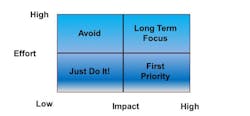The Critical First Step Toward Collaboration and Improvement
“We want to start a new improvement initiative. What do you recommend we do first?” asks an executive.
I often get asked this question the first time I visit an organization that has expressed an interest in introducing a team-based, collaborative effort to improve their processes. Before answering, I spend time listening to each leader, and then I do some digging to try and confirm the following assumptions: 1) the leaders who want to launch the improvement initiative are fully on board and understand what is required to increase the chances of success, 2) the leaders comprehend their role and the changes they might need to make in their own leadership style in order to improve collaboration and trust with the workforce, and 3) the leaders are ready to provide resources, employee time and financial support in order to help facilitate the improvements.
If these assumptions prove to be false, then I recommend to the organization’s leadership that the improvement initiative be put on hold. It is far better to do nothing than it is to have a false launch that comes crashing down. The damage that a failed initiative will cause can result in significant amounts of ill will throughout the workforce and can set back improvement efforts for years.
If the assumptions prove to be true, my recommendation for a first step is to pick one or two areas of the organization and go out and ask the employees closest to where the work is being done for ideas on how they would improve their part of the process. This does two things: It begins to develop critical thinking skills within the workforce and as ideas get implemented, it develops ownership and buy-in. However, there are many pitfalls to avoid in order for a strong foundation to be built for all of the future improvement steps that will follow.
To show how difficult this first step might be (especially if there is little to no trust between employees and the leaders), I have included an excerpt from my new book, The Façade of Excellence: Defining a New Normal of Leadership. Jim Brown, a new divisional V.P. has requested that his reluctant operations manager, Susan Jones, go out and ask some of the employees for their ideas about how to improve. Susan is accustomed to working for “old style” managers before Jim showed up and has never tried to engage workers to this extent. This excerpt provides a snapshot of what might happen:
“Excuse me,” said Susan to one of the workers. “Do you mind if I interrupt your break and ask you a couple of questions? My name is Susan Jones and I would like to discuss any ideas you might have in how we could get better.”
“Yes, I know who you are Ms. Jones. My name is Mary Robinson and I have worked here for over 10 years and I believe that this is the first time someone in your position has spoken to me. Am I in some sort of trouble? Did I do something wrong? Oh my…am I being fired? I can’t afford to lose this job!”
“No, Mary, your job is safe. As you probably know, we have a new V.P. running this business and he would like to shake things up a bit around here. He would like some of the workers to share ideas on ways we can improve our processes.”
“Wait… Isn’t that your job?” asked Mary. “Aren’t you supposed to supply ideas on how to get better? I think this is all a way to get rid of jobs and then blame me and the other workers when things turn bad. Why should I trust you to do the right thing?”
“You know, Mary, I can see why you might feel this way. I guess we have not done a very good job of building trust with any of our workers.”
“I am constantly being told by my supervisor to quit thinking and just do my job,” replied Mary. “And if I don’t meet my quotas or make a mistake of some kind, I am told that my rear end will be out on the street. Then, I get bad material to work with and a machine that is constantly breaking down… kind of hard to build trust when things are this bad for the workers.”
“Look,” said Susan with a tone of frustration, “I am sorry to interrupt your break. Please head back to work and forget this ever happened. I knew this was a bad idea.” With that said, she put away her notebook and got up to leave.
Before Susan had gotten too far down the aisle, Mary shouted, “If I give you some ideas, what are you going to do with them? I mean, if I am going to go to all of the trouble to share with you how we can do things better, I deserve to know how these ideas are going to be used. Are you going to write them down in your notebook and then toss them into the trash? Or, use them as your own and try to get a promotion?”
Susan turned around and walked back to where Mary was sitting. “No, Mary… none of those things. Actually, I am going to write your ideas down, along with several others, on big pieces of paper and post them in the entrance of the building for everyone to see. If you would like, I can include your name for each of your ideas or you can be anonymous, whichever you prefer. Then, our goal will be to decide which ideas to implement. Once these decisions are made, you have my word that I will return and let you know what happened.”
“Humph!” replied Mary. “I still don’t trust you or your new boss. It was pretty cool though when he tore up those quality reports in the parking lot the other day. Most of us knew that those reports were not worth squat and had no reflection on what was really going on around here. I really do need this job and hope to work here for as long as I can… maybe things really will change. For 10 years, I have been performing work at this station and have had a lot of time to think about doing all of these tasks in a different way. For example, all of my parts are stored way over there on shelves by the aisle. Why can’t they be stored here at my work station? I must walk 5 miles a day just getting the parts I need to do my job.”
Susan wrote Mary’s idea down and then the flood gates opened. After 15 minutes, Susan had recorded over a dozen ideas on ways to improve this one workstation. She thanked Mary for her inputs and again promised to get back to her regarding what would happen. “Wow,” thought Susan as she headed back to her office. “This was not what I was expecting. With no real training on how to improve processes, Mary was able to give me several good ways to make things run smoother. Maybe our workers actually do have something to contribute when it comes to deciding how we can get better.” (From: The Façade of Excellence: Defining a New Normal of Leadership, Reprinted with permission from Productivity Press, © 2019 John Dyer)
Once ideas have been collected from the employees, it is critically important to treat them with dignity and respect. Early in my career at General Electric, I remember facilitating one of the first teams that included shop floor workers. We asked for their ideas and wrote them on index cards and taped them to one of the walls in the meeting room. I remember that we got well over 50 ideas, an overwhelming number that had to be prioritized and culled down if we had any hope of getting some of them implemented.
To begin this process, I removed a card that I thought had an idea that would never see the light of day. I read the idea out loud and asked the group if anyone would object if I took the card off of the wall. No one objected, so I threw the card into the trash. What a mistake! Fortunately, this happened right before we took a break, and during this down time, one of the participants came up to me and said, “That was my idea you just threw into the trash. I know this is your first time to facilitate a group so I am going to give you this piece of advice. If you want me or any of the other workers to continue to participate, you will be a bit more careful with what you do with our ideas.”
I immediately went over to the trash can, fished out the index card and put it back on the wall where it belonged. We never did implement that particular idea, but that was not the point. In that one moment of insincerity, our entire improvement efforts could have come to a grinding halt. I thanked that employee and apologized to the entire group and made sure that from that point forward, it did not happen again.
If it damages the relationship to eliminate ideas, what is the best way to prioritize them in order to focus on the ones that might have a real impact? There are several tools to help prioritize a list of items, such as multivoting, using selection criteria or force ranking. The tool I like to use is a simple four block that looks like this:
The facilitator takes each idea and asks the group which square it belongs in based on their understanding of how much effort will be required to implement the idea and the degree of impact to removing waste and improving the quality and flow of their process. It helps to put some definitions around these two criteria. For example, the line that separates “high” and “low” on the effort side might be defined as $1,000 of investment and 10 hours of labor to implement (or whatever is appropriate for your organization).
Impact can be a bit trickier. As I explain in my book, it helps to have a well-defined vision to allow all employees to see the future direction of the organization. Once this is done, the question can then be asked: “Does this idea help us inch closer to our vision?” If the answer is “yes,” then the idea would move toward the right side of the four block.
Once the ideas are sorted and prioritized, the next critical step is to communicate with the participants the status of each of their ideas. One rule I try to always use is that the only person who can remove an idea from the list, either because it is complete or other ideas that were implemented have now made this one obsolete, is the original author. This helps assure that proper communication is taking place about the status of each idea.
At some point throughout this process, the organization will need to provide training to the employees. The first round of ideas (low hanging fruit) can be gathered rather easily without much training. However, future rounds will require tools and methodologies to aid the employees and further enhance their critical thinking skills. Be sure to utilize training that is fun, engaging and interactive since this is the most effective way for adults to learn.
Throughout this process, approach the workforce with a sense of humbleness, intense interest in their thoughts, and a dedication to making progress toward collaboration and improvement. Be sure to celebrate and recognize the contributions when improvement ideas are implemented and metrics clearly indicate that progress has been made. This will encourage additional ideas to be lifted up and begin to build worker pride and ownership, which will lead to what I like to call "enthusiastic productivity." If this first step in the improvement process is done well, it will establish a strong foundation that will help launch the next steps toward achieving excellence.
About the Author

John Dyer
President, JD&A – Process Innovation Co.
John Dyer is president of JD&A – Process Innovation Co. and has 32 years of experience in the field of improving processes. He started his career with General Electric and then worked for Ingersoll-Rand before starting his own consulting company.
John is the author of The Façade of Excellence: Defining a New Normal of Leadership, published by Productivity Press. He is a frequent speaker on topics of leadership, continuous improvement, teamwork and culture change, both within and outside the manufacturing industry.
John is a contributing editor for IndustryWeek, and frequently helps judge the annual IndustryWeek Best Plants Awards competition. He also has presented sessions at the annual IW conference.
John has an electrical engineering degree from Tennessee Tech University, as well as an international master's of business from Purdue University and the University of Rouen in France.
He can be reached by telephone at (704) 658-0049 and by email at [email protected]. View his LinkedIn profile here.

